Ryobi CSB125 User Manual [en, es, fr]
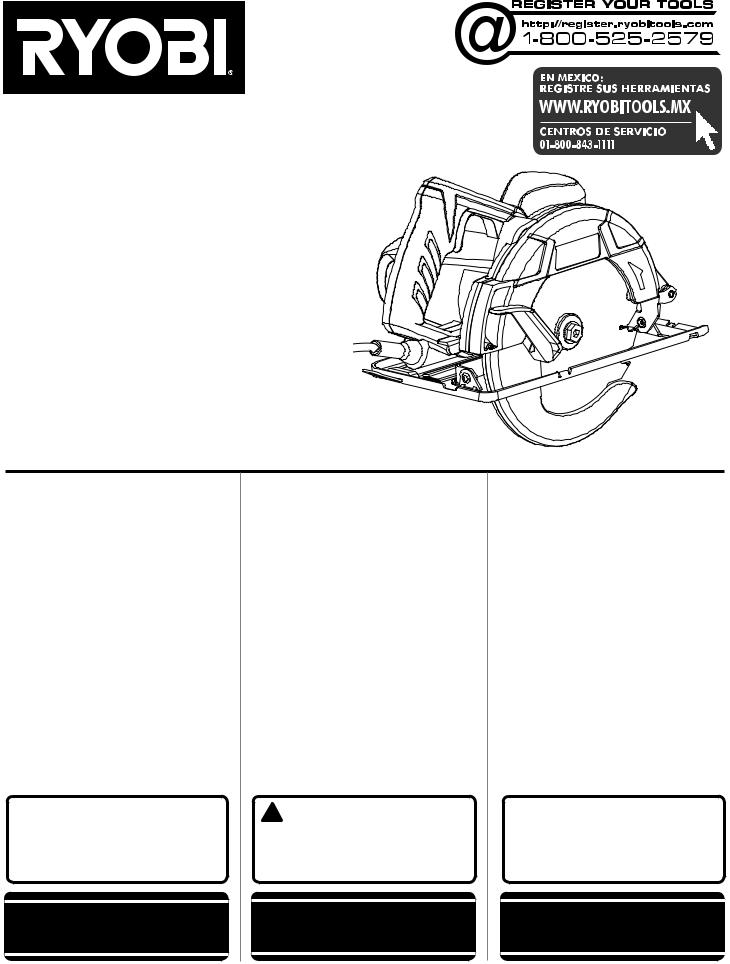
OPERATOR’S MANUAL
MANUEL D’UTILISATION MANUAL DEL OPERADOR
7-1/4 in. CIRCULAR SAW
DOUBLE INSULATED
SCIE CIRCULAIRE DE 184 mm (7-1/4 po)
DOUBLE ISOLATION
SIERRA CIRCULAR DE 184 mm (7-1/4 pulg.)
DOBLE AISLAMIENTO
CSB125
INCLUDES: Circular Saw, 7-1/4 in. Blade, Blade Wrench, Operator’s Manual
TABLE OF CONTENTS
****************
General Power Tool Safety |
|
|
Warnings.......................................... |
|
2-3 |
Circular Saw Safety Warnings |
.........3-5 |
|
Symbols.............................................. |
|
6 |
Electrical............................................. |
|
7 |
Features.............................................. |
|
8 |
Assembly......................................... |
|
8-9 |
Operation....................................... |
|
9-13 |
Adjustments...................................... |
|
14 |
Maintenance..................................... |
|
15 |
Accessories....................................... |
|
15 |
Illustrations................................... |
|
16-19 |
Parts Ordering / Service...... |
Back Page |
|
 WARNING: To reduce the risk of injury, the user must read and understand the operator’s manual before using this product.
WARNING: To reduce the risk of injury, the user must read and understand the operator’s manual before using this product.
SAVE THIS MANUAL FOR FUTURE REFERENCE
INCLUT : Scie circulaire, lame de 184 mm (7-1/4 po), clé de lame, manuel d’utilisation
TABLE DES MATIÈRES
****************
Règles de sécurité relatives |
|
|
aux outils électriques....................... |
|
2-3 |
Avertissements de sécurité |
|
|
relatifs au scie circulaire.................. |
|
3-5 |
Symboles............................................ |
|
6 |
Caractéristiques électriques |
...............7 |
|
Caractéristiques.................................. |
|
8 |
Assemblage..................................... |
|
8-9 |
Utilisation....................................... |
|
9-13 |
Réglages........................................... |
|
14 |
Entretien............................................ |
|
15 |
Accessoires....................................... |
|
15 |
Illustrations................................... |
|
16-19 |
Commande de pièces / |
|
|
réparation.......................... |
Page arrière |
|
 AVERTISSEMENT : Pour
AVERTISSEMENT : Pour
réduire les risques de blessures, l’utilisateur doit lire et veiller à bien comprendre le manuel d’utilisation avant d’employer ce produit.
CONSERVER CE MANUEL POUR FUTURE RÉFÉRENCE
INCLUYE: Sierra circular, hoja de 184 mm (7-1/4 pulg.), llave de la hoja, manual del operador
ÍNDICE DE CONTENIDO
****************
Advertencias de seguridad |
|
|
para herramientas eléctricas |
...........2-3 |
|
Advertencias de seguridad |
|
|
sierra circular................................... |
|
3-5 |
Símbolos............................................. |
|
6 |
Aspectos eléctricos............................ |
|
7 |
Características.................................... |
|
8 |
Armado............................................ |
|
8-9 |
Funcionamiento............................. |
|
9-13 |
Ajustes.............................................. |
|
14 |
Mantenimiento.................................. |
|
15 |
Accesorios........................................ |
|
15 |
Ilustraciones................................. |
|
16-19 |
Pedidos de piezas / |
|
|
servicio.......................... |
Pág. posterior |
|
 ADVERTENCIA: Para reducir el riesgo de lesiones, el usuario debe leer y comprender el manual del operador antes de usar este producto.
ADVERTENCIA: Para reducir el riesgo de lesiones, el usuario debe leer y comprender el manual del operador antes de usar este producto.
GUARDE ESTE MANUAL PARA FUTURAS CONSULTAS

GENERAL POWER TOOL SAFETY WARNINGS
 WARNING
WARNING
Read all safety warnings and all instructions. Failure to follow the warnings and instructions may result in electric shock, fire and/or serious injury.
Save all warnings and instructions for future reference.
The term “power tool” in the warnings refers to your mainsoperated (corded) power tool or battery-operated (cordless) power tool.
WORK AREA SAFETY
Keep work area clean and well lit. Cluttered or dark areas invite accidents.
Do not operate power tools in explosive atmospheres, such as in the presence of flammable liquids, gases or dust. Power tools create sparks which may ignite the dust or fumes.
Keep children and bystanders away while operating a power tool. Distractions can cause you to lose control.
ELECTRICAL SAFETY
Power tool plugs must match the outlet. Never modify the plug in any way. Do not use any adapter plugs with earthed (grounded) power tools. Unmodified plugs and matching outlets will reduce risk of electric shock.
Avoid body contact with earthed or grounded surfaces such as pipes, radiators, ranges and refrigerators.
There is an increased risk of electric shock if your body is earthed or grounded.
Do not expose power tools to rain or wet conditions.
Water entering a power tool will increase the risk of electric shock.
Do not abuse the cord. Never use the cord for carrying, pulling or unplugging the power tool. Keep cord away from heat, oil, sharp edges or moving parts. Damaged or entangled cords increase the risk of electric shock.
When operating a power tool outdoors, use an extension cord suitable for outdoor use. Use of a cord suitable for outdoor use reduces the risk of electric shock.
If operating a power tool in a damp location is unavoidable, use a ground fault circuit interrupter (GFCI) protected supply. Use of a GFCI reduces the risk of electric shock.
PERSONAL SAFETY
Stay alert, watch what you are doing and use common sense when operating a power tool. Do not use a power tool while you are tired or under the influence of drugs, alcohol or medication. A moment of inattention while operating power tools may result in serious personal injury.
Use personal protective equipment. Always wear eye protection. Protective equipment such as dust mask, nonskid safety shoes, hard hat, or hearing protection used for appropriate conditions will reduce personal injuries.
Prevent unintentional starting. Ensure the switch is in the off-position before connecting to power source and/or battery pack, picking up or carrying the tool.
Carrying power tools with your finger on the switch or energising power tools that have the switch on invites accidents.
Remove any adjusting key or wrench before turning the power tool on. A wrench or a key left attached to a rotating part of the power tool may result in personal injury.
Do not overreach. Keep proper footing and balance at all times. This enables better control of the power tool in unexpected situations.
Dress properly. Do not wear loose clothing or jewellery. Keep your hair, clothing and gloves away from moving parts. Loose clothes, jewellery or long hair can be caught in moving parts.
If devices are provided for the connection of dust extraction and collection facilities, ensure these are connected and properly used. Use of dust collection can reduce dust-related hazards.
Do not wear loose clothing or jewelry. Contain long hair. Loose clothes, jewelry, or long hair can be drawn into air vents.
Do not use on a ladder or unstable support. Stable footing on a solid surface enables better control of the power tool in unexpected situations.
POWER TOOL USE AND CARE
Do not force the power tool. Use the correct power tool for your application. The correct power tool will do the job better and safer at the rate for which it was designed.
Do not use the power tool if the switch does not turn it on and off. Any power tool that cannot be controlled with the switch is dangerous and must be repaired.
Disconnect the plug from the power source and/or the battery pack from the power tool before making any adjustments, changing accessories, or storing power tools. Such preventive safety measures reduce the risk of starting the power tool accidentally.
Store idle power tools out of the reach of children and do not allow persons unfamiliar with the power tool or these instructions to operate the power tool. Power tools are dangerous in the hands of untrained users.
Maintain power tools. Check for misalignment or binding of moving parts, breakage of parts and any other condition that may affect the power tool’s operation. If damaged, have the power tool repaired before use. Many accidents are caused by poorly maintained power tools.
2 - English
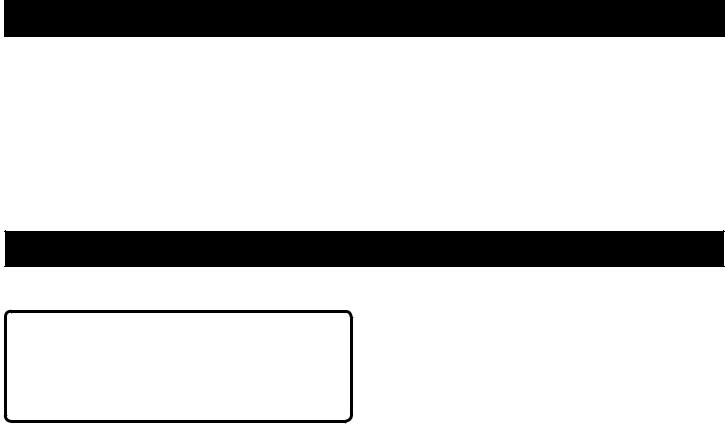
GENERAL POWER TOOL SAFETY WARNINGS
Keep cutting tools sharp and clean. Properly maintained cutting tools with sharp cutting edges are less likely to bind and are easier to control.
Use the power tool, accessories and tool bits etc. in accordance with these instructions, taking into account the working conditions and the work to be performed. Use of the power tool for operations different from those intended could result in a hazardous situation.
SERVICE
Have your power tool serviced by a qualified repair person using only identical replacement parts. This will ensure that the safety of the power tool is maintained.
When servicing a power tool, use only identical replacement parts. Follow instructions in the Maintenance section of this manual. Use of unauthorized parts or failure to follow Maintenance instructions may create a risk of shock or injury.
CIRCULAR SAW SAFETY WARNINGS
CUTTING PROCEDURES
 DANGER:
DANGER:
Keep hands away from cutting area and the blade. Keep your second hand on auxiliary handle, or motor housing. If both hands are holding the saw, they cannot be cut by the blade.
Do not reach underneath the workpiece. The guard can not protect you from the blade below the workpiece.
Adjust the cutting depth to the thickness of the workpiece. Less than a full tooth of the blade teeth should be visible below the workpiece.
Never hold piece being cut in your hands or across your leg. Secure the workpiece to a stable platform.
It is important to support the work properly to minimize body exposure, blade binding, or loss of control.
Hold the power tool by insulated gripping surfaces only, when performing an operation where the cutting tool may contact hidden wiring or its own cord. Contact with a “live” wire will also make exposed metal parts of the power tool “live” and could give the operator an electric shock.
When ripping, always use a rip fence or straight edge guide. This improves the accuracy of cut and reduces the chance of blade binding.
Always use blades with correct size and shape (diamond versus round) of arbour holes. Blades that do not match the mounting hardware of the saw will run eccentrically, causing loss of control.
Never use damaged or incorrect blade washers or bolt. The blade washers and bolt were specially designed for your saw, for optimum performance and safety of operation.
KICKBACK CAUSES AND RELATED WARNINGS
Kickback is a sudden reaction to a pinched, bound or misaligned saw blade, causing an uncontrolled saw to lift up and out of the workpiece toward the operator;
When the blade is pinched or bound tightly by the kerf closing down, the blade stalls and the motor reaction drives the unit rapidly back toward the operator;
If the blade becomes twisted or misaligned in the cut, the teeth at the back edge of the blade can dig into the top surface of the wood causing the blade to climb out of the kerf and jump back toward the operator.
Kickback is the result of saw misuse and/or incorrect operating procedures or conditions and can be avoided by taking proper precautions as given below:
Maintain a firm grip with both hands on the saw and position your arms to resist kickback forces. Position your body to either side of the blade, but not in line with the blade. Kickback could cause the saw to jump backwards, but kickback forces can be controlled by the operator, if proper precautions are taken.
When blade is binding, or when interrupting a cut for any reason, release the trigger and hold the saw motionless in the material until the blade comes to a complete stop. Never attempt to remove the saw from the work or pull the saw backward while the blade is in motion or kickback may occur. Investigate and take corrective actions to eliminate the cause of blade binding.
When restarting a saw in the workpiece, centre the saw blade in the kerf and check that saw teeth are not engaged into the material. If saw blade is binding, it may walk up or kickback from the workpiece as the saw is restarted.
Support large panels to minimise the risk of blade pinching and kickback. Large panels tend to sag under their own weight. Supports must be placed under the panel on both sides, near the line of cut and near the edge of the panel.
3 - English

CIRCULAR SAW SAFETY WARNINGS
Do not use dull or damaged blades. Unsharpened or improperly set blades produce narrow kerf causing excessive friction, blade binding and kickback.
Bladedepthandbeveladjustinglockingleversmustbe tight and secure before making cut. If blade adjustment shifts while cutting, it may cause binding and kickback.
Use extra caution when sawing into existing walls or other blind areas. The protruding blade may cut objects that can cause kickback.
LOWER GUARD FUNCTION
Check lower guard for proper closing before each use. Do not operate the saw if lower guard does not move freely and close instantly. Never clamp or tie the lower guard into the open position. If saw is accidentally dropped, lower guard may be bent. Raise the lower guard with the retracting handle and make sure it moves freely and does not touch the blade or any other part, in all angles and depths of cut.
Check the operation of the lower guard spring. If the guard and the spring are not operating properly, they must be serviced before use. Lower guard may operate sluggishly due to damaged parts, gummy deposits, or a build-up of debris.
Lower guard should be retracted manually only for special cuts such as “plunge cuts” and “compound cuts.” Raise lower guard by retracting handle and as soon as blade enters the material, the lower guard must be released. For all other sawing, the lower guard should operate automatically.
Always observe that the lower guard is covering the blade before placing saw down on bench or floor. An unprotected, coasting blade will cause the saw to walk backwards, cutting whatever is in its path. Be aware of the time it takes for the blade to stop after switch is released.
ADDITIONAL SAFETY WARNINGS
Use clamps or other practical way to secure and support the workpiece to a stable platform. Holding the work by hand or against your body is unstable and may lead to loss of control.
Know your power tool. Read operator’s manual carefully. Learn its applications and limitations, as well as the specific potential hazards related to this tool.
Following this rule will reduce the risk of electric shock, fire, or serious injury.
Always wear eye protection with side shields marked to comply with ANSI Z87.1. Failure to do so could result in objects being thrown into your eyes, resulting in possible serious injury.
Protect your lungs. Wear a face or dust mask if the operation is dusty. Following this rule will reduce the risk of serious personal injury.
Protect your hearing. Wear hearing protection during extended periods of operation. Following this rule will reduce the risk of serious personal injury.
Inspect tool cords periodically and, if damaged, have repaired at your nearest authorized service center. Constantly stay aware of cord location. Following this rule will reduce the risk of electric shock or fire.
Check damaged parts. Before further use of the tool, a guard or other part that is damaged should be carefully checked to determine that it will operate properly and perform its intended function. Check for alignment of moving parts, binding of moving parts, breakage of parts, mounting, and any other conditions that may affect its operation. A guard or other part that is damaged should be properly repaired or replaced by an authorized service center. Following this rule will reduce the risk of shock, fire, or serious injury.
Make sure your extension cord is in good condition. When using an extension cord, be sure to use one heavy enough to carry the current your product will draw. A wire gauge size (A.W.G.) of at least 12 is recommended for an extension cord 50 feet or less in length. A cord exceeding 100 feet is not recommended. If in doubt, use the next heavier gauge. The smaller the gauge number, the heavier the cord.
An undersized cord will cause a drop in line voltage resulting in loss of power and overheating.
Inspect for and remove all nails from lumber before using this tool. Following this rule will reduce the risk of serious personal injury.
If the power supply cord is damaged, it must be replaced only by the manufacturer or by an authorized service center to avoid risk.
Save these instructions. Refer to them frequently and use them to instruct others who may use this tool. If you loan someone this tool, loan them these instructions also.
4 - English
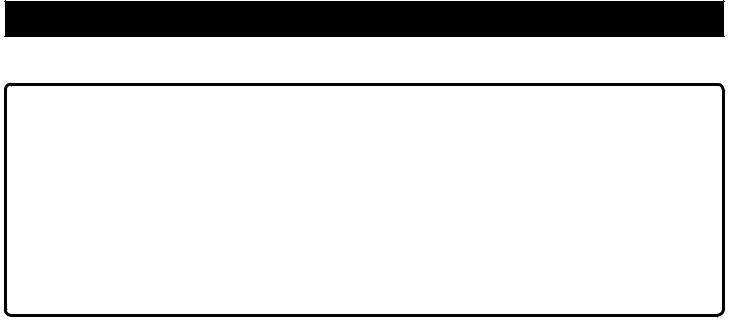
CIRCULAR SAW SAFETY WARNINGS
CALIFORNIA PROPOSITION 65
 WARNING:
WARNING:
This product and some dust created by power sanding, sawing, grinding, drilling, and other construction activities may contain chemicals, including lead, known to the State of California to cause cancer, birth defects, or other reproductive harm. Wash hands after handling.
Some examples of these chemicals are:
•lead from lead-based paints,
•crystalline silica from bricks and cement and other masonry products and,
•arsenic and chromium from chemically treated lumber.
Your risk from exposure to these chemicals varies, depending on how often you do this type of work. To reduce your exposure, work in a well-ventilated area and with approved safety equipment, such as dust masks that are specially designed to filter out microscopic particles.
5 - English
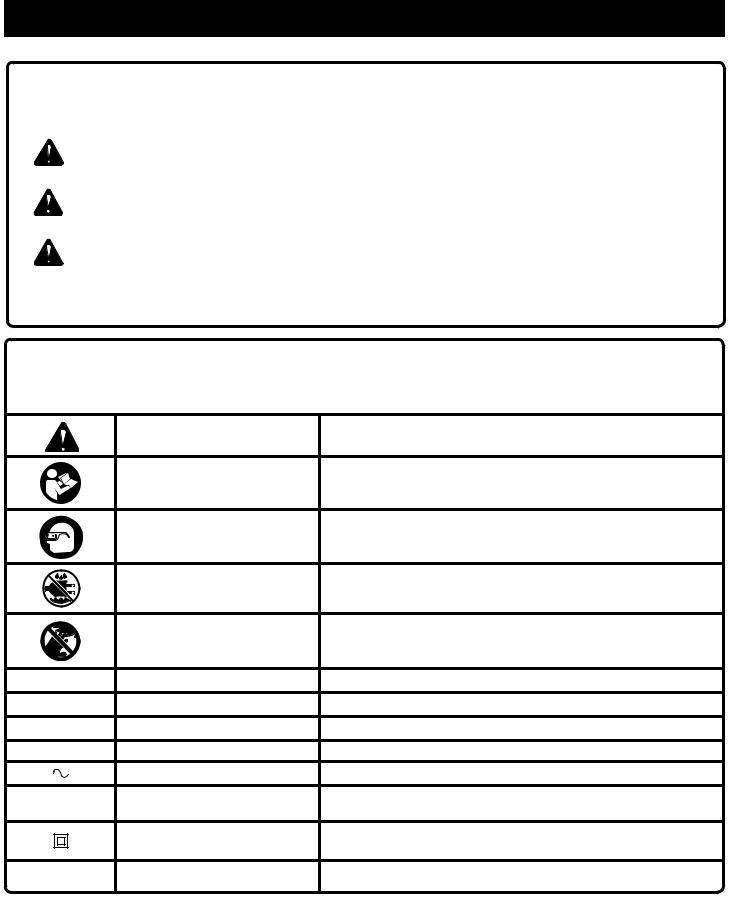
SYMBOLS
The following signal words and meanings are intended to explain the levels of risk associated with this product.
SYMBOL |
SIGNAL |
MEANING |
|
|
|
|
|
|
DANGER: |
Indicates an imminently hazardous situation, which, if not avoided, will |
|
|
result in death or serious injury. |
||
|
|
||
|
|
|
|
|
WARNING: |
Indicates a potentially hazardous situation, which, if not avoided, could |
|
|
result in death or serious injury. |
||
|
|
||
|
|
|
|
|
CAUTION: |
Indicates a potentially hazardous situation, which, if not avoided, may |
|
|
result in minor or moderate injury. |
||
|
|
||
|
|
|
|
|
NOTICE: |
(Without Safety Alert Symbol) Indicates important information not related |
|
|
to an injury hazard, such as a situation that may result in property damage. |
||
|
|
||
Some of the following symbols may be used on this product. Please study them and learn their meaning. Proper interpretation of these symbols will allow you to operate the product better and safer.
SYMBOL |
NAME |
DESIGNATION/EXPLANATION |
|
Safety Alert |
Indicates a potential personal injury hazard. |
|
Read Operator’s Manual |
To reduce the risk of injury, user must read and understand |
|
operator’s manual before using this product. |
|
|
|
|
|
Eye Protection |
Always wear eye protection with side shields marked to comply |
|
with ANSI Z87.1. |
|
|
|
|
|
Wet Conditions Alert |
Do not expose to rain or use in damp locations. |
|
No Hands Symbol |
Failure to keep your hands away from the blade will result in |
|
serious personal injury. |
|
|
|
|
V |
Volts |
Voltage |
A |
Amperes |
Current |
Hz |
Hertz |
Frequency (cycles per second) |
min |
Minutes |
Time |
|
Alternating Current |
Type of current |
no |
No Load Speed |
Rotational speed, at no load |
|
Class II Construction |
Double-insulated construction |
.../min |
Per Minute |
Revolutions, strokes, surface speed, orbits etc., per minute |
6 - English
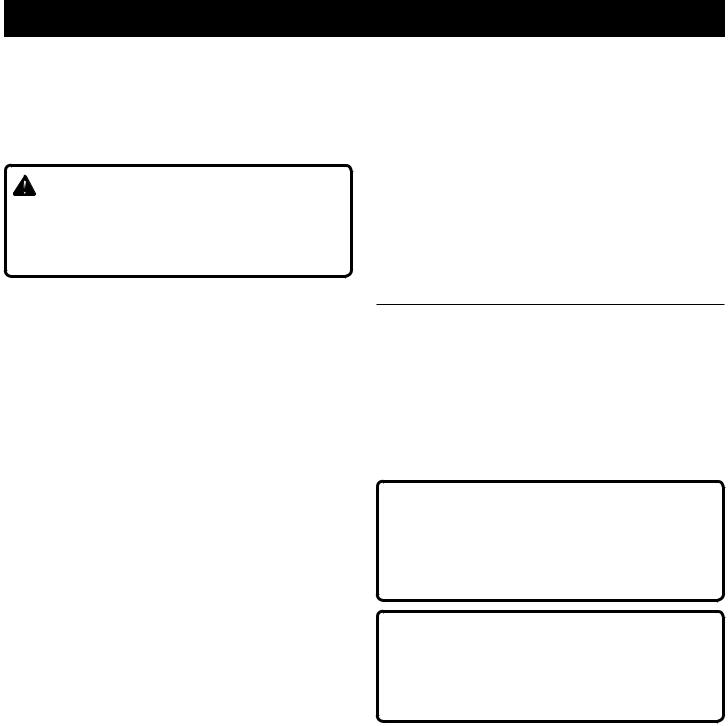
ELECTRICAL
DOUBLE INSULATION
Double insulation is a concept in safety in electric power tools, which eliminates the need for the usual three-wire grounded power cord. All exposed metal parts are isolated from the internal metal motor components with protecting insulation. Double insulated tools do not need to be grounded.
WARNING:
The double insulated system is intended to protect the user from shock resulting from a break in the tool’s internal insulation. Observe all normal safety precautions to avoid electrical shock.
NOTE: Servicing of a product with double insulation requires extreme care and knowledge of the system and should be performed only by a qualified service technician. For service, we suggest you return the product to your nearest authorized service center for repair. Always use original factory replacement parts when servicing.
ELECTRICAL CONNECTION
This product has a precision-built electric motor. It should be connected to a power supply that is 120 V, AC only (normal household current), 60 Hz. Do not operate this product on direct current (DC). A substantial voltage drop will cause a loss of power and the motor will overheat. If the product does not operate when plugged into an outlet, double-check the power supply.
EXTENSION CORDS
When using a power tool at a considerable distance from a power source, be sure to use an extension cord that has the capacity to handle the current the product will draw. An undersized cord will cause a drop in line voltage, resulting in overheating and loss of power. Use the chart to determine the minimum wire size required in an extension cord. Only round jacketed cords listed by Underwriter’s Laboratories (UL) should be used.
When working outdoors with a product , use an extension cord that is designed for outside use. This type of cord is designated with “WA” or “W” on the cord’s jacket.
Before using any extension cord, inspect it for loose or exposed wires and cut or worn insulation.
**Ampere rating (on product data plate) |
|
|
|
|||
|
0-2.0 |
2.1-3.4 3.5-5.0 |
5.1-7.0 |
7.1-12.0 |
12.1-16.0 |
|
Cord Length |
|
Wire Size (A.W.G.) |
|
|
||
|
|
|
|
|
|
|
25' |
16 |
16 |
16 |
16 |
14 |
14 |
|
|
|
|
|
|
|
50' |
16 |
16 |
16 |
14 |
14 |
12 |
|
|
|
|
|
|
|
100' |
16 |
16 |
14 |
12 |
10 |
— |
|
|
|
|
|
|
|
**Used on 12 gauge - 20 amp circuit.
NOTE: AWG = American Wire Gauge
 WARNING:
WARNING:
Keep the extension cord clear of the working area. Position the cord so that it will not get caught on lumber, tools, or other obstructions while you are working with a power tool. Failure to do so can result in serious personal injury.
 WARNING:
WARNING:
Check extension cords before each use. If damaged replace immediately. Never use the product with a damaged cord since touching the damaged area could cause electrical shock resulting in serious injury.
7 - English
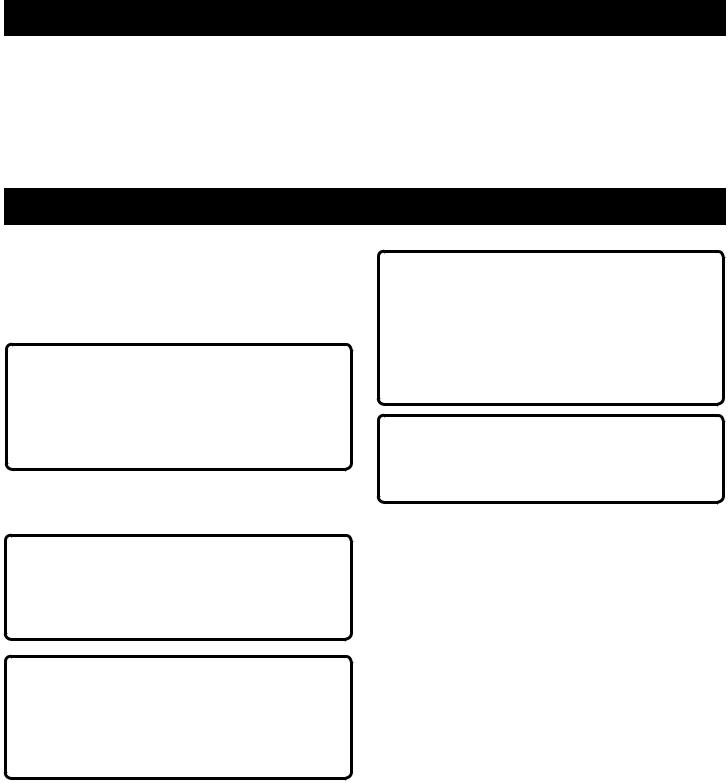
FEATURES
PRODUCT SPECIFICATIONS
Blade Diameter...................................................... |
7-1/4 in. |
Blade Arbor............................................................... |
5/8 in. |
Cutting Depth at 0º.............................................. |
2-7/16 in. |
Cutting Depth at 45º.............................................. |
1-7/8 in. |
Cutting Depth at 51.5º |
.......................................1-11/16 in. |
No Load Speed..................................... |
5,000 r/min. (RPM) |
Input................................. |
120 V, AC only, 60 Hz, 13 Amps |
ASSEMBLY
UNPACKING
This product requires assembly.
nCarefully remove the tool and any accessories from the box. All items listed in the Includes section must be included at the time of purchase.
 WARNING:
WARNING:
Items in this Assembly section are not assembled to the product by the manufacturer and require customer installation. Use of a product that may have been improperly assembled could result in serious personal injury.
nIf any parts are damaged or missing, please call 1-800-525-2579 for assistance. In Mexico, please call 01-800-843-1111.
 WARNING:
WARNING:
If any parts are damaged or missing do not operate this product until the parts are replaced. Use of this product with damaged or missing parts could result in serious personal injury.
 WARNING:
WARNING:
Do not attempt to modify this product or create accessories or attachments not recommended for use with this product. Any such alteration or modification is misuse and could result in a hazardous condition leading to possible serious personal injury.
 WARNING:
WARNING:
A 7-1/4 in. blade is the maximum blade capacity of the saw. Also, never use a blade that is too thick to allow outer blade washer to engage with the flat on the spindle. Larger blades will come in contact with the blade guards, while thicker blades will prevent blade screw from securing blade on spindle. Either of these situations could result in a serious accident.
NOTICE:
To prevent damage to the spindle or spindle lock, always allow motor to come to a complete stop before engaging spindle lock.
ATTACHING BLADE
See Figures 1 - 3, pages 16 - 17. n Unplug the saw.
n Depress and hold spindle lock button.
nRemove blade screw by turning it counterclockwise with the blade wrench, while keeping the spindle lock button depressed.
nRemove spring washer and outer blade washer (“D” washer).
nWipe a drop of oil onto the inner flange bushing and outer blade washer (“D” washer) where they contact blade.
nRetract the lower blade guard into the upper blade guard using the lower blade guard handle. Make sure the lower guard spring works properly, allowing the guard to move freely.
nCheck to see that the saw teeth and arrow on the saw blade and the arrow on the upper guard are pointing in the same direction.
NOTE: The saw teeth point upward at the front of the saw as shown.
8 - English
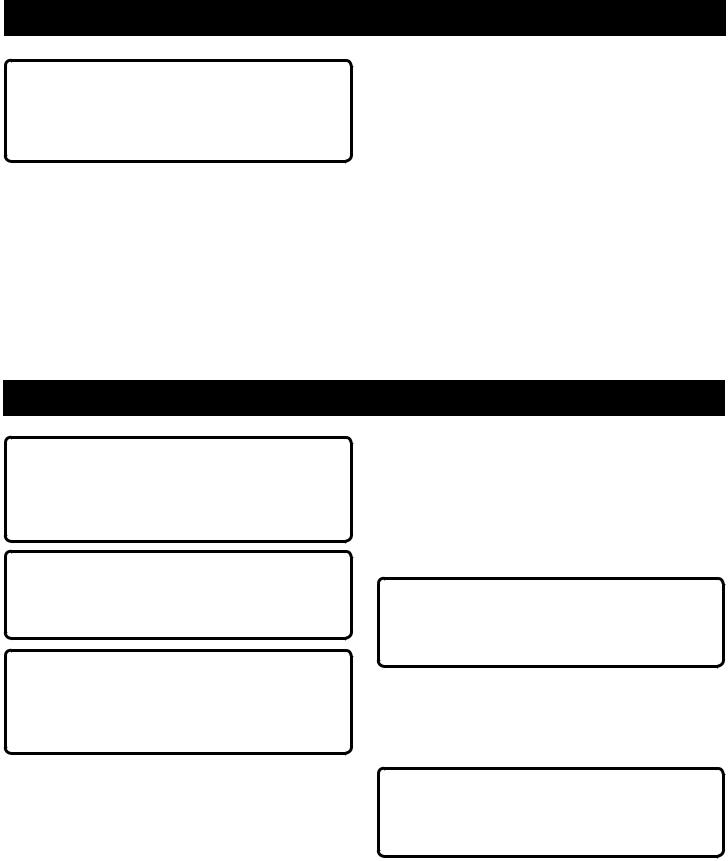
ASSEMBLY
 WARNING:
WARNING:
If inner flange bushing has been removed, replace it before placing blade on spindle. Failure to do so will prevent blade from tightening properly and could result in serious personal injury.
nFit the saw blade inside the lower blade guard and onto the spindle.
nReplace “D” washer.
nReplace spring washer with cupped side against “D” washer.
nDepress spindle lock button and replace blade screw.
nTighten blade screw securely by turning it clockwise with the blade wrench.
NOTE: Never use a blade that is too thick to allow the “D” washer to engage with the flat on the spindle.
REMOVING BLADE
See Figures 1 - 3, pages 16 - 17.
Unplug the saw.
Depress and hold spindle lock button.
Remove blade screw by turning it counterclockwise with the blade wrench, while keeping the spindle lock button depressed.
Remove spring washer and outer blade washer (“D” washer).
Lift lower blade guard.
Remove blade.
OPERATION
 DANGER:
DANGER:
Keep hands away from cutting area and the blade. Keep your second hand on auxiliary handle. If both hands are holding the saw, they cannot be cut by the blade.
 WARNING:
WARNING:
Do not allow familiarity with this product to make you careless. Remember that a careless fraction of a second is sufficient to inflict serious injury.
 WARNING:
WARNING:
Always wear eye protection with side shields marked to comply with ANSI Z87.1. Failure to do so could result in objects being thrown into your eyes resulting in possible serious injury.
APPLICATIONS
You may use this product for the purposes listed below:
Cutting all types of wood products (lumber, plywood, paneling, composition board, and hard board)
Cross cutting/rip cutting wood products
Bevel cutting wood products
Pocket cutting wood products
 WARNING:
WARNING:
Never use abrasive cut-off wheels of any kind with this saw. Use of non wood cutting blades can result in property damage or serious personal injury.
KICKBACK
See Figures 4 - 7, page 17.
Kickback occurs when the blade stalls rapidly and the saw is driven back towards you. Blade stalling is caused by any action which pinches the blade in the wood.
 DANGER:
DANGER:
Release switch immediately if blade binds or saw stalls. Kickback could cause you to lose control of the saw. Loss of control can lead to serious injury.
9 - English
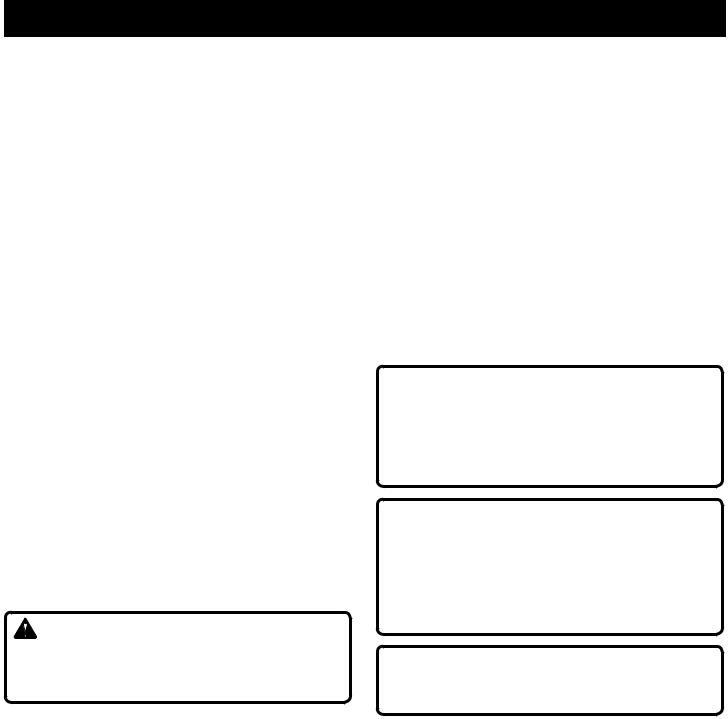
OPERATION
To guard against kickback, avoid dangerous practices such as the following:
Setting blade depth incorrectly
Sawing into knots or nails in workpiece
Twisting the blade while making a cut
Making a cut with a dull, gummed up, or improperly set blade
Supporting the workpiece incorrectly
Forcing a cut
Cutting warped or wet lumber
Operating the tool incorrectly or misusing the tool
To lessen the chance of kickback, follow these safety practices:
Keep the blade at the correct depth setting. Less than a full tooth of the blade teeth should be visible below the workpiece.
Inspect the workpiece for knots or nails before cutting. Never saw into a knot or nail.
Make straight cuts. Always use a straight edge guide when rip cutting. This helps prevent twisting the blade.
Use clean, sharp, and properly set blades. Never make cuts with dull blades.
Support and clamp the workpiece properly before beginning a cut.
Use steady, even pressure when making a cut. Never force a cut.
Do not cut warped or wet lumber.
Hold the saw firmly with both hands and keep your body in a balanced position so as to resist the forces if kickback should occur.
WARNING:
When using the saw, always stay alert and exercise control. Do not remove the saw from the workpiece while the blade is moving.
SAW BLADES
The best of saw blades will not cut efficiently if they are not kept clean, sharp, and properly set. Using a dull blade will place a heavy load on the saw and increase the danger of kickback. Keep extra blades on hand, so that sharp blades are always available.
Gum and wood pitch hardened on blades will slow the saw down. Remove saw blade from the saw and use gum and pitch remover, hot water, or kerosene to remove these accumulations. DO NOT USE GASOLINE.
BLADE GUARD SYSTEM
See Figure 8, page 17.
The lower blade guard attached to the circular saw is there for your protection and safety. Do not alter it for any reason. If it becomes damaged, do not operate the saw until you have the guard repaired or replaced. Always leave guard in operating position when using the saw.
 DANGER:
DANGER:
When sawing through work, lower blade guard does not cover blade on the underside of work. Since blade is exposed on underside of work, keep hands and fingers away from cutting area. Any part of your body coming in contact with moving blade will result in serious injury.
 CAUTION:
CAUTION:
Never use saw when guard is not operating correctly. Check the guard for correct operation before each use. The guard is operating correctly when it moves freely and readily returns to the closed position. If you drop the saw, check the lower blade guard and bumper for damage at all depth settings before reuse.
 WARNING:
WARNING:
Never tie the lower blade guard in a raised position. Leaving the blade exposed could lead to serious injury.
If at any time the lower blade guard does not snap closed, unplug the saw from the power supply. Exercise the lower guard by moving it rapidly back and forth from the full open position to the closed position several times. Normally this will restore the guard to its normal operating condition. If it does not correct a slow or sluggish closing lower guard, do not use the saw. Take it to an authorized factory service center for repair.
10 - English
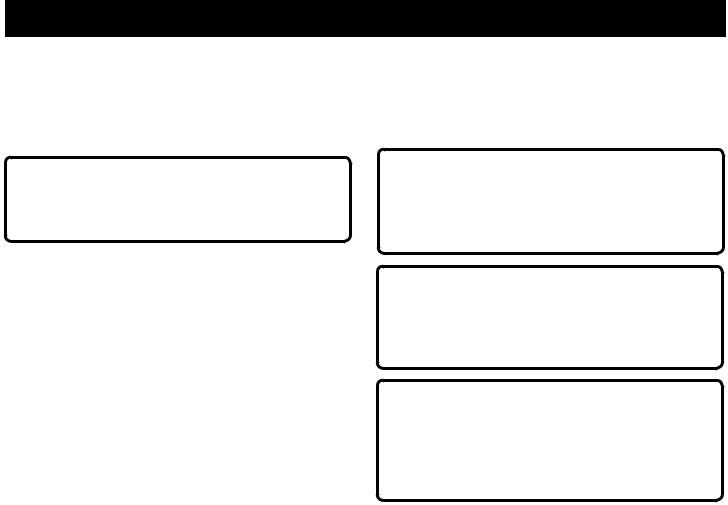
OPERATION
STARTING/STOPPING THE SAW
See Figure 9, page 17.
To start the saw: Depress the switch.
Always let the blade reach full speed, then guide the saw into the workpiece.
 WARNING:
WARNING:
The blade coming in contact with the workpiece before it reaches full speed could cause the saw to “kick back” towards you resulting in serious injury.
To stop the saw: Release the switch.
After you release the switch, allow the blade to come to a complete stop. Do not remove the saw from the workpiece while the blade is moving.
ADJUSTING BLADE DEPTH
See Figure 10, page 17.
Always keep correct blade depth setting. Less than a full tooth of the blade teeth should be visible below the workpiece. More blade depth will increase the chance of kickback and cause the cut to be rough. For more depth of cut accuracy, a scale is located on the upper blade guard.
To adjust the blade depth:
Unplug the saw.
Pull depth lock lever upward to release. The depth lock lever is located between the guard and handle of the saw.
Determine the desired depth of cut.
Locate depth of cut scale on back of upper blade guard.
Hold base flat against the workpiece and raise or lower saw until the index point (or reference mark) on bracket aligns with notch on blade guard.
Push down on the depth lock lever to lock the lever in place and secure the position.
OPERATING THE SAW
See Figures 11 - 13, pages 17 - 18.
It is important to understand the correct method for operating the saw. Refer to the figures in this section to learn the correct and incorrect ways for handling the saw.
 WARNING:
WARNING:
To make sawing easier and safer, always maintain proper control of the saw, by holding the saw with both hands. Loss of control could cause an accident resulting in possible serious injury.
 DANGER:
DANGER:
When lifting the saw from the workpiece, the blade is exposed on the underside of the saw until the lower blade guard closes. Make sure the lower blade guard is closed before setting the saw down.
 WARNING:
WARNING:
Use clamps or other practical way to secure and support the workpiece to a stable platform. Holding the work by hand or against your body is unstable and may lead to loss of control which could cause possible serious injury.
To make the best possible cut:
Hold the saw firmly with both hands.
Avoid placing your hand on the workpiece while making a cut.
Support the workpiece so that the cut (kerf) is always to your side.
Support the workpiece near the cut.
Clamp the workpiece securely so that the workpiece will not move during the cut.
Always place the saw on the workpiece that is supported, not the “cut off” piece.
Place the workpiece with the “good” side down.
Draw a guideline along the desired line of cut before beginning your cut.
11 - English

OPERATION
 DANGER:
DANGER:
If the cord hangs up on the workpiece during a cut, release the switch immediately and allow the blade to come to a complete stop. Unplug the saw and reposition the cord to prevent it from hanging up again.
 WARNING:
WARNING:
Using a saw with a damaged cord could result in serious injury or death. If the cord has been damaged, have it replaced before using the saw again.
CROSS CUTTING/RIP CUTTING
See Figures 14 - 15, page 18.
When making a cross cut or rip cut, align the line of cut with the blade guide notch on the base.
Since blade thicknesses vary, always make a trial cut in scrap material along a guideline to determine how much, if any, you must offset the guideline to produce an accurate cut.
NOTE: The distance from the line of cut to the guideline is the amount you should offset the guide.
TO RIP CUT WITHOUT EDGE GUIDE
See Figure 15, page 18.
Use a guide when making long or wide rip cuts with the saw.
NOTE: You may also use a edge guide to make rip cuts. Refer to Optional Edge Guide later in this manual.
Secure the workpiece.
Clamp a straight edge to the workpiece using C-clamps.
Saw along the straight edge to achieve a straight rip cut. NOTE: Do not bind the blade in the cut.
BEVEL CUTTING
See Figures 16 - 17, page 18.
To make the best possible cut, follow these helpful hints.
Align the line of cut with the inner blade guide notch on the base when making 45° bevel cuts.
Make a trial cut in scrap material along a guideline to determine how much you should offset the guideline on the cutting material.
Adjust the angle of the cut to any desired setting between zero and 51.5°. Refer to To Adjust Bevel Setting next.
TO ADJUST BEVEL SETTING
See Figure 16 - 17, page 18.
Unplug the saw.
Loosen bevel lock knob.
Rotate motor housing end of saw until you reach desired angle setting on bevel scale.
Tighten bevel lock knob securely.
 WARNING:
WARNING:
Attempting a bevel cut without having the bevel lock knob securely tightened can result in serious injury.
TO BEVEL CUT
See Figure 18, page 18.
Hold the saw firmly with both hands as shown.
Rest the front edge of the base on the workpiece.
Start the saw and let the blade reach full speed.
Guide the saw into the workpiece and make the cut.
Release the switch and allow the blade to come to a complete stop.
Lift the saw from the workpiece.
POCKET CUTTING
See Figure 19, page 18.
 WARNING:
WARNING:
Always adjust bevel setting to zero before making a pocket cut. Attempting a pocket cut at any other setting can result in loss of control of the saw possibly causing serious injury.
■ Adjust the bevel setting to zero.
Set the blade to the correct blade depth setting.
Swing the lower blade guard up using the lower blade guard handle.
NOTE: Always raise the lower blade guard with the handle to avoid serious injury.
Hold the lower blade guard by the handle while keeping your hand on the front handle as shown.
Rest the front of the base flat against the workpiece with the rear of the handle raised so the blade does not touch the workpiece.
Start the saw and let the blade reach full speed.
Guide the saw into the workpiece and make the cut.
12 - English

OPERATION
 WARNING:
WARNING:
Always cut in a forward direction when pocket cutting. Cutting in the reverse direction could cause the saw to climb up on the workpiece and back toward you.
Release the switch and allow the blade to come to a complete stop.
Lift the saw from the workpiece.
Clear corners out with a hand saw or sabre saw.
LENGTH OF CUT SCALE
See Figure 20, page 18.
The saw is equipped with a length of cut scale on its base. It is parallel with the saw blade and can be used to measure the distance into the material the blade cuts.
NOTE: Six inches is the maximum length of cut that you can measure. Also, it is accurate only when the depth of cut is set at full maximum depth.
OPTIONAL EDGE GUIDE KIT
See Figure 21, page 19.
Use the optional edge guide kit, part no. 202218001 when making long or wide rip cuts with the saw.
To assemble edge guide:
Unplug the saw.
Place edge guide through slots in base as shown.
Adjust edge guide to the width needed.
Tighten edge guide lock knob securely.
To use edge guide:
Secure the workpiece to prevent movement.
Position the face of the edge guide firmly against the edge of workpiece.
Guide the saw along the edge to achieve a straight rip cut.
NOTE: The guiding edge of the workpiece must be straight for the cut to be straight. Use caution to prevent the blade from binding in the cut.
OPTIONAL DUST NOZZLE KIT
See Figure 22, page 19.
You may purchase a dust nozzle kit, part no. 200673002, for use with the saw. The adaptor fits over the dust chute which is located on the upper blade guard. The nozzle attaches to the adaptor.
NOTE: If you use the nozzle, you should always connect it to a standard vacuum hose.
To attach dust nozzle:
Unplug the saw.
Lift lower blade guard.
Orient adaptor to fit into the dust chute opening on upper blade guard.
Secure adaptor with screw provided.
Align hole in nozzle with raised lip on adaptor and snap into place when using a vacuum hose.
13 - English
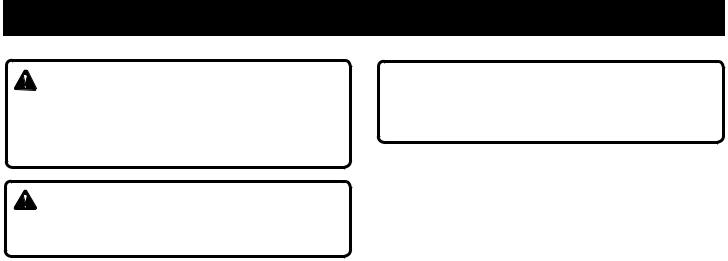
ADJUSTMENTS
WARNING:
Before performing any adjustment, make sure the tool is unplugged from the power supply and the switch is in the OFF position. Failure to heed this warning could result in serious personal injury.
WARNING:
Never tie the lower blade guard in a raised position. Leaving the blade exposed could lead to serious injury.
0° BEVEL STOP
See Figure 23, page 19.
The saw has a 0° bevel stop that has been factory adjusted to assure 0° angle of the saw blade when making 90° cuts.
To check 0° bevel stop:
Unplug the saw.
Place the saw in an upside down position on a workbench.
Check the squareness of the saw blade plate to the base of the saw using a combination square.
To adjust 0° bevel stop:
Unplug the saw.
Loosen bevel lock knob.
Loosen hex nut securing adjusting screw.
Turn adjusting screw and adjust base until square with saw blade.
Tighten hex nut and bevel lock knob securely.
 WARNING:
WARNING:
Attempting a bevel cut without having the bevel lock knob securely tightened can result in serious injury.
ADJUSTING THE DEPTH LOCK LEVER
See Figure 24, page 19.
Over time, due to wear, the depth lock lever may move from its original setting. If the lever prematurely contacts any part of the saw during tightening and loosening, adjust the lever by following these steps:
Unplug the saw.
Pull depth lock lever upward to release.
Pull saw base down to the minimum depth of cut position, then push the depth lock lever down to secure.
Insert a flathead screwdriver into the space between the lock nut and the E-ring. Remove the E-ring.
Note the position of the lever on the nut. Slide the depth lock lever off the lock nut.
The lock nut has six flat sides. Rotate the depth lock lever one “flat” counter clockwise around the nut. Then slide it back into place.
Push the E-ring back into the groove on the lock nut until it snaps into place. Take care that the E-ring does not pop off the lock nut.
Loosen the depth lock lever and return the base to the full depth of cut position and lock the depth setting by pushing downward on the depth lock lever. The base should be locked securely in position when locked and be free to move when released.
14 - English

MAINTENANCE
 WARNING:
WARNING:
When servicing, use only identical replacement parts. Use of any other parts can create a hazard or cause product damage.
 WARNING:
WARNING:
Always wear eye protection with side shields marked to comply with ANSI Z87.1. Failure to do so could result in objects being thrown into your eyes resulting in possible serious injury.
GENERAL MAINTENANCE
Avoid using solvents when cleaning plastic parts. Most plastics are susceptible to damage from various types of commercial solvents and may be damaged by their use. Use clean cloths to remove dirt, dust, oil, grease, etc.
 WARNING:
WARNING:
Do not at any time let brake fluids, gasoline, petroleumbased products, penetrating oils, etc., come in contact with plastic parts. Chemicals can damage, weaken or destroy plastic which can result in serious personal injury.
Electrictoolsusedonfiberglassmaterial,wallboard,spackling compounds, or plaster are subject to accelerated wear and possible premature failure because the fiberglass chips and grindings are highly abrasive to bearings, brushes, commutators,etc.Consequently,wedonotrecommendusing this product for extended work on these types of materials. However, if you do work with any of these materials, it is extremely important to clean the product using compressed air.
LUBRICATION
All of the bearings in this product are lubricated with a sufficient amount of high grade lubricant for the life of the unit under normal operating conditions. Therefore, no further lubrication is required.
POWER SUPPLY CORD REPLACEMENT
If replacement of the power supply cord is necessary, this has to be done by the manufacturer or his agent in order to avoid a safety hazard.
ACCESSORIES
To order these accessories, call 1-800-525-2579.
|
Edge Guide Kit................................................................................................................................................. |
202218001 |
|
Dust Nozzle Kit................................................................................................................................................. |
200673002 |
WARNING:
Current attachments and accessories available for use with this product are listed above. Do not use any attachments or accessories not recommended by the manufacturer of this product. The use of attachments or accessories not recommended can result in serious personal injury.
NOTE: ILLUSTRATIONS START ON PAGE 16 AFTER FRENCH AND SPANISH LANGUAGE SECTIONS.
This product has a Three-year Limited Warranty.
For Warranty details go to www.ryobitools.com
15 - English
